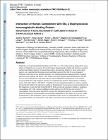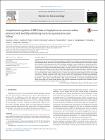| dc.contributor.author | FOSTER, TIMOTHY JAMES | |
| dc.contributor.author | GEOGHEGAN, JOAN | |
| dc.date.accessioned | 2013-07-09T09:10:37Z | |
| dc.date.available | 2013-07-09T09:10:37Z | |
| dc.date.issued | 2012 | |
| dc.date.submitted | 2012 | en |
| dc.identifier.citation | Sharp JA, Echague CG, Hair PS, Ward MD, Nyalwidhe JO, Geoghegan JA, Foster TJ, Cunnion KM, Staphylococcus aureus surface protein SdrE binds complement regulator factor H as an immune evasion tactic., PloS one, 7, 5, 2012, e38407 | en |
| dc.identifier.other | Y | |
| dc.identifier.uri | http://hdl.handle.net/2262/66653 | |
| dc.description | PUBLISHED | en |
| dc.description.abstract | Similar to other highly successful invasive bacterial pathogens, Staphylococcus aureus recruits the complement regulatory protein factor H (fH) to its surface to inhibit the alternative pathway of complement. Here, we report the identification of the surface-associated protein SdrE as a fH-binding protein using purified fH overlay of S. aureus fractionated cell wall proteins and fH cross-linking to S. aureus followed by mass spectrometry. Studies using recombinant SdrE revealed that rSdrE bound significant fH whether from serum or as a purified form, in both a time- and dose-dependent manner. Furthermore, rSdrE-bound fH exhibited cofactor functionality for factor I (fI)-mediated cleavage of C3b to iC3b which correlated positively with increasing amounts of fH. Expression of SdrE on the surface of the surrogate bacterium Lactococcus lactis enhanced recruitment of fH which resulted in increased iC3b generation. Moreover, surface expression of SdrE led to a reduction in C3-fragment deposition, less C5a generation, and reduced killing by polymorphonuclear cells. Thus, we report the first identification of a S. aureus protein associated with the staphylococcal surface that binds factor H as an immune evasion mechanism. | en |
| dc.description.sponsorship | This work was supported by a grant from the National Institutes of Health: R21AI082398 (www.nih.gov) to KM Cunnion and by Science Foundation Ireland Programme Investigator grant 08/IN.1/B1845 to TJ Foster. The funders had no role in study design, data collection and analysis, decision to publish, or preparation of the manuscript. | en |
| dc.format.extent | e38407 | en |
| dc.language.iso | en | en |
| dc.relation.ispartofseries | PloS one; | |
| dc.relation.ispartofseries | 7; | |
| dc.relation.ispartofseries | 5; | |
| dc.rights | Y | en |
| dc.subject | bacterial protein; complement component C3; complement component C3b; complement component C5a; complement factor H; membrane protein; protein SdrE; recombinant protein; unclassified drug; bacterial protein; ClfA protein, Staphylococcus aureus; coagulase; complement component C3b; complement component C5a; complement factor H; recombinant protein; SdrE protein, Staphylococcus aureus | en |
| dc.subject.lcsh | bacterial protein; complement component C3; complement component C3b; complement component C5a; complement factor H; membrane protein; protein SdrE; recombinant protein; unclassified drug; bacterial protein; ClfA protein, Staphylococcus aureus; coagulase; complement component C3b; complement component C5a; complement factor H; recombinant protein; SdrE protein, Staphylococcus aureus | en |
| dc.title | Staphylococcus aureus surface protein SdrE binds complement regulator factor H as an immune evasion tactic. | en |
| dc.type | Journal Article | en |
| dc.type.supercollection | scholarly_publications | en |
| dc.type.supercollection | refereed_publications | en |
| dc.identifier.peoplefinderurl | http://people.tcd.ie/tfoster | |
| dc.identifier.peoplefinderurl | http://people.tcd.ie/geoghejo | |
| dc.identifier.rssinternalid | 81713 | |







